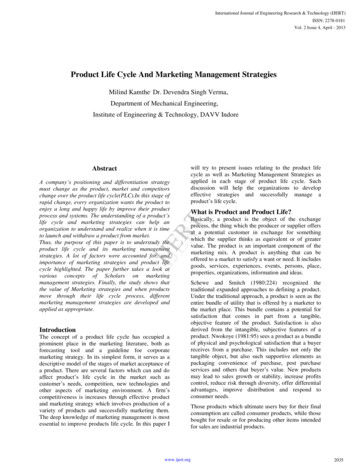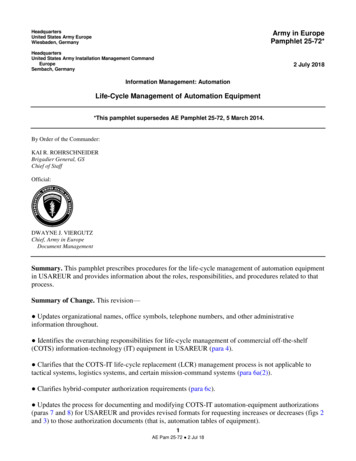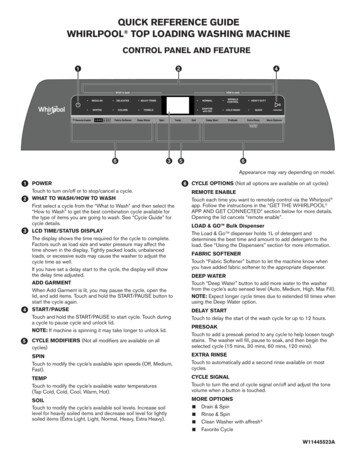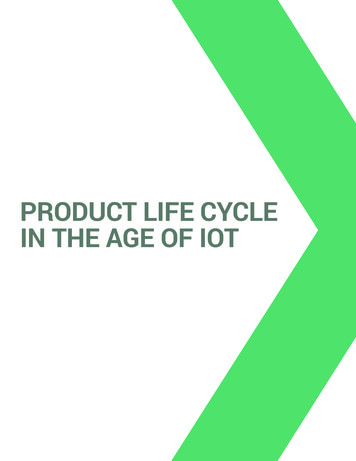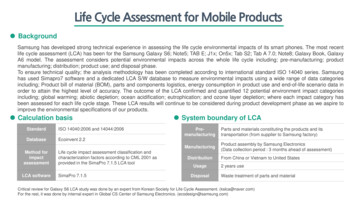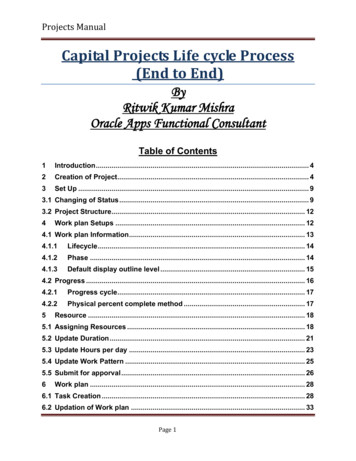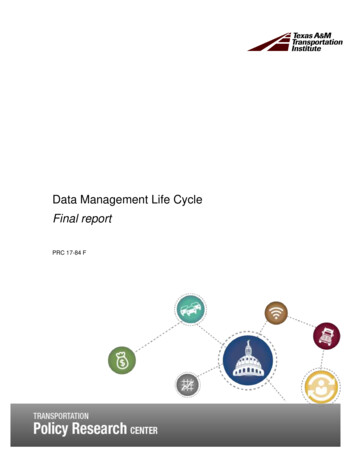
Transcription
Data Management Life CycleFinal reportPRC 17-84 F
Data Management Life CycleTexas A&M Transportation InstitutePRC 17-84 FMarch 2018AuthorsKristi MillerMatt MillerMaarit MoranBoya DaiCopies of this publication have been deposited with the Texas State Library in compliance with theState Depository Law, Texas Government Code §441.101-106.2
Data Management Life CycleTransportation inefficiencies cost money, reduce safety, increase pollution-causing emissions,and take time away from people’s lives. In transportation, decision-makers use data to assessalternatives, weigh tradeoffs, and to evaluate performance. Stakeholders use data to assess thecomprehensive performance of a transportation organization. The public uses data to inform theirpersonal decisions and travel behavior. Transportation data is a key component for policyresearch and performance management.This report provides a roadmap of data management to be used for high-level prioritization forfuture research efforts. Researchers developed the data management life cycle to organize data,characterize its nature and value over time, and identify policy implications of cross-cutting datamanagement issues.The report discusses the seven phases data moves through in its life cycle: Collection. Process. Store and secure. Use. Share and communicate. Archive. Destroy or re-use (concurrent phases).The following cross-cutting issues in the data management lifecycle, which occur and canchange over the life cycle, but effect each of the life cycle phases, are also identified anddiscussed: Purpose and value. Privacy. Data ownership. Liability. Public perception. Security. Standards and Data Quality.3
The volume of transportation data expands continually. Technological advances are happening ata rapid pace, generating large amounts of data that appear to be valuable in understanding theissues that form transportation policy. As data continues to expand, it is important for policymakers to know the value of data and the return on investment for collection and analyzing data.Data-driven insight can serve to inform policy decisions at all levels, helping to conserve limitedpublic funds and ensure the most efficient and effective use of transportation systems.4
Table of ContentsData Management Life Cycle . 3List of Figures . 6List of Tables . 6Introduction . 7Data Management Life Cycle . 9Data Management Life Cycle Phases . 12Collect . 12Techniques and Methods for Data Collection.12Partnerships for Data Collection .12Impact of Technology and Big Data .13Process . 14Data Quality Metrics.15Data Processing Techniques .15Store and Secure . 16Use. . 16Share and Communicate . 18Communication and Transparency .18Coordination .19Costs and Maintenance of Shared Data .19Access .19Archive . 20Reuse/Repurpose or Destroy . 22Reuse/Repurpose .22Destroy.23Cross-Cutting Issues in Data Management . 26Purpose and Value . 26Privacy . 26Data Ownership . 30Liability . 33Public Perception. 34Security. 34Standards and Data Quality . 37Policy Implications . 40References . 425
List of FiguresFigure 1. Data Management Life Cycle and Cross-Cutting Issues in Data Management. . 11Figure 2. AASHTO Core Data Principles. 15Figure 3. Model of Data Use by DOTs. Source: Cambridge Systematics. . 17Figure 4. Use of ITS Data for Other Transportation Purposes. . 21Figure 5. Vehicle Data Transfer and Ownership . . 32List of TablesTable 1. 2015 Status and Description of Select ALPR Laws in the United States. . 14Table 2. Proposed and Enacted Privacy Legislation in Texas. . 28Table 3. Data Security Breach Definitions across States . . 366
IntroductionTransportation inefficiencies cost money, reduce safety, increase pollution-causing emissions,and take time away from people’s lives. The solution is not always to build more roads, createparking spaces, or add more bus routes. Sometimes, the better solution is to do more with theinfrastructure we already have, and for that, you need information on which to base decisions.Data are raw material representing actions or transactions in the real world that are recorded,classified, processed, stored, and potentially repurposed to create information that supportspolicy and decision making. The end user interprets the meaning to draw conclusions andidentify implications of the information (1). In transportation, decision-makers use data to assessalternatives, weigh tradeoffs, and to evaluate performance. Stakeholders use data to assess thecomprehensive performance of a transportation organization. The public uses data to inform theirpersonal decisions and travel behavior.Transportation data are a key component for policy research and performance management.Examples of data that reflect the wide range of data sources used for transportation purposesinclude the following: Crash records that reveal incident location and contributing factors. Probe speed and volume data to inform congestion mitigation and management efforts. Census data to show demographic and socioeconomic characteristics, populationdistribution, and change. Roadway inventory to estimate the supply and demand of infrastructures. Travel behavior data to identify patterns and trends. Public opinion data to reflect attitudes and awareness of transportation issues. Road weather information data to alert travelers to roadway conditions and trafficoperations.The volume of transportation data expands continually. Technological advances are happening ata rapid pace, generating large amounts of data that appear to be valuable in understanding theissues that form transportation policy. As data continues to expand, it is important for policymakers to know the value of data and the return on investment for collecting and analyzing data.The importance of data in this era of data-driven decision making, the swift increase in thevolume of data due to improved collection methods, new uses such as automated and connectedvehicles, and increased interest on the part of the public in factors underlying decision making,suggests that policymakers may have an interest in understanding and addressing the quantity,quality, creation, collection, storage, retention, privacy, security, and availability oftransportation data across agencies.7
This paper attempts to bring clarity to the topic of data—to simplify and organize it intosomething that is digestible. By better understanding the data landscape as a whole, policymakers can better understand the role of each piece of data as it relates to transportation, as wellas in other areas. This report provides a roadmap of data management to be used for high-levelprioritization for future research efforts.The report is organized as follows: Data Management Life Cycle. This section describes the process used to categorize datatopics and develop the data management life cycle, as well as introduces the componentsof the data management life cycle. Data Management Life Cycle Phases. This section describes each of the eight phases inthe data management life cycle in detail. Cross-cutting Issues in Data Management. This section describes eight issues that cutacross all phases of data management. Summary. This section summarizes the data life cycle and provides suggestions for futureresearch efforts.8
Data Management Life CycleAccurate, timely data is an important input for making accurate, timely transportation planningand policy decisions. However, the management of data is challenging and must be addressedover the life span of a piece of data. Transportation agencies already manage many of theirphysical assets: roads, bridges, signs, lights, etc. Data can be treated like other physical assets.Data is a key component in decision-making, so it is important to also carefully manage andmaintain data to know what data exists, where it is located, how it can be obtained, and if it isaccurate. Furthermore, data are often expensive to procure, so one would want to make sure theright data are available to support key decisions.Data as a topic is so broad; it can be overwhelming and difficult to grasp all the elements itencompasses. Through a cyclical and iterative process, researchers at TTI identified possibleaspects and uses of data in the transportation context and developed a framework of what dataexists, and then condensed the topics into cross-cutting issues and main themes in the datamanagement life cycle. This life cycle presents a way to organize data, characterize its natureand value over time, and identify policy implications of cross-cutting data management issues.Illustrated in Figure 1, the data management life cycle describes key aspects of data fromcreation to destruction, as well as cross-cutting issues that affect data in each phase of the lifecycle. Data moves through seven phases in its life cycle: Collect. Process. Store and secure. Use. Share and communicate. Archive. Destroy or re-use (concurrent phases).Researchers at TTI also identified seven cross-cutting issues in the data management lifecycle,which occur and can change over the life cycle, but affect each of the seven life cycle phases(Figure 1). Some cross-cutting issues are pivotal to each life cycle phase, and all have policyimplications. The cross-cutting issues are: Purpose and value. Privacy. Data ownership. Liability.9
Public perception. Security. Standards and Data Quality.10
Figure 1. Data Management Life Cycle and Cross-Cutting Issues in Data Management.11
Data Management Life Cycle PhasesThe stages of the data management life cycle—collect, process, store and secure, use, share andcommunicate, archive, reuse/repurpose, and destroy—are described in this section.CollectThe first phase of the data management life cycle is data collection. Data is being collected for amyriad of reasons, such as operations, maintenance, planning, performance measures, or toaddress a certain policy goal or objective. The key factors in this stage are: Techniques and methods for collection. Public versus private sector data generation, procurement, and partnerships for datacollection. Impact of technology and big data.Techniques and Methods for Data CollectionTransportation data relate to people, vehicles, assets, physical infrastructure, and travel. Users ofthe information derived from the data are key stakeholders in the data collection and analysisprocess. Depending on the needs of the user, the data collection type and methodology vary atdifferent geographic and jurisdictional levels. Data collection systems should be designed tomeet both internal and external user needs and the agency’s legislative mandates. The planningand design of data collection system includes establishing data needs and objectives, identifyingdata providers, planning and designing methods to meet data needs and objectives, anddocumenting data collection and designs (2).Data collection methods should be determined based on factors such as funding availability, dataquantity, length of collection period, research questions, and target populations. Future researchshould be focused on examining ways that public agencies can harness big data from privateentities.Partnerships for Data CollectionData collection can be challenging for transportation agencies with limited time, resources, andtechnology. The process of identifying and collecting accurate and useful data requires technicalexpertise and well-developed tools. A public-private partnership in this case could help tofacilitate data collection and enhance agencies’ ability to be data-driven developmentpractitioners and decision makers. Currently, Texas’ public-private partnership mostly focuseson the State’s facilities and infrastructure projects. There is a lack of formal guidance onpotential collaboration of data collection. Before entering a public-private partnership, it iscritical to be aware of existing data ownership policies and clearly describe rights and obligationsso data integrity is not compromised.12
There are multiple ways vehicle data is collected by public and private sector sources. In thepublic sector, sensors on roads put in place by local and state DOTs collect vehicle speed andvolume data that is not associated with the personal identity of the vehicle owner. In the privatesector, individual vehicle telematics data is obtained via cellular backhaul transmissions bytelecommunications companies who have agreements in place to route the data to automotivemanufacturers who then use it for various purposes.Impact of Technology and Big DataCollection and exploitation of large data sets for transportation operations, planning, and safetypurposes is not new; in the past data were acquired, processed, and discarded. Now with low-costand widespread sensing across all modes and types of infrastructure, they are acquired,processed, and stored for some later currently unknown use.It is important to understand what data have been generated and how to use them to shape thefuture of transportation in Texas. Millions of devices have been equipped with Internet of things(IoT) technology. The IoT refers to “the network of physical objects or “things” embedded withelectronics, software, sensors, and network connectivity, which enables these objects to collectand exchange data” (3). Application of the IoT extends to all aspects of transportation systems,(i.e., the vehicle, the infrastructure, and the driver or user). It automates data collection andgenerates a massive pool of data (Big Data) from diverse locations that is aggregated veryquickly. For example, Google has crowd sourced the collection of real time traffic data viamobile phones. If the Google Maps app is installed on a mobile phone with GPS capabilitiesenabled, Google can collect the location and travel data of the phone user in real time. WhenGoogle combines the speed collected from all the phones on road, they are able to evaluate livetraffic conditions and send it back to user for navigation.Federal and state laws and rules place requirements on the collection of certain data related tovarious aspects of transportation. One example in the field of new transportation-relatedtechnologies are recently developed laws involving data collection requirements surroundingautomated license plate reader systems (ALPR) mounted on police cars, road signs, and trafficlights that capture geo-located and temporal data aligned with PII data from these systems. Giventhe PII, data collection requirements have been created for ALPRs across various states. Table 1describes some of these laws (4).13
Table 1. 2015 Status and Description of Select ALPR Laws in the United States.Arkansas (Passed)Highway police division can utilize the automatic license plate reader systemto collect ALPR data for the electronic verification of registration, logs, andother compliance data for commercial vehicles on a state highway and forinstallation at an entrance ramp at a weigh station facility for the review of acommercial motor vehicle entering the facility.California (Passed)Imposes specified requirements on an automated license plate recognitionoperator to ensure that the information the operator collects is protectedwith certain safeguards, and implements specified security procedures and ausage and privacy policy with respect to that information. Requires theoperator to maintain a specified record of any information access. Requirespublic input regarding any public entity program. Includes specified informationto be considered personal information for breach purposes.Illinois (Pending)Allows law enforcement agency to use ALPR data and historical ALPR data onlyfor legitimate law enforcement purposes. Prevents ALPR data from being tradedor shared for any other purpose.Texas (Failed)Law enforcement agency may use an automatic license plate reader. All imagesand data produced from an automatic license plate reader shall be destroyednot later than the 90th day after the date of collection unless the image or datais evidence in a criminal investigation or prosecution.Minnesota (Pending)Relates to data practices; classifies data related to automated license platereaders; requires a log of use; requires data to be destroyed in certaincircumstances.Data sets, often referred to as Big Data, of this magnitude and complexity are proliferating inpart because data is increasingly being continuously gathered by ubiquitous information-sensingmobile devices, GPS devices, remote sensing technologies, software logs, cameras, microphones,radio-frequency identification readers, and wireless sensor networks. Examples of Big Datasources in transportation research include probe data, GPS data, Bluetooth sensors, mobiledevices, and cameras.ProcessData processing is the second phase of the data management life cycle that takes a primary rolein converting the data collected in the first stage of the life cycle to meaningful information.When data is collected, it may not be in a readily usable form. The process starts withdiscovering inconsistencies and other anomalies in the data into raw data, as well as datacleansing to improve the data quality. Users could then conduct analyses to produce meaningful14
information based on the data that may lead to a resolution of a problem or improvement of anexisting situation. The key factors in this stage include: Data quality metrics. Quality assurance and quality control. Data processing techniques.Data Quality MetricsData quality metrics identify data errors and erroneous data elements and measure the impact ofvarious data-driven processes. A data quality assessment enables transportation agencies tounderstand the condition of their safety and traffic data, for example, in relation to expectations.It could assist agencies in understanding how effectively data represents the objects, events, andconcepts it is designed to represent. AASHTO has developed seven core data principles to haveconsistency among states, listed in Figure 2.Figure 2. AASHTO Core Data Principles.Source: (5)Data Processing TechniquesTransportation agencies, research entities, and private companies are seeking to tap theinformation power within big data to create more effective decision making. It poses challengesto the traditional management and analysis, which lacks the capabilities to handle the complexdata sources and amount of information. To extract and mine massive transportation data fromvarious databases, it is important to understand and use advanced data processing techniques andtools. The Bureau of Transportation Statistics provides general instructions on data processing inthe Guide to Good Statistical Practice in the Transportation Field (6). This guide includesprinciples and guidelines on data editing and coding, handling missing data, production ofestimates and projections, and data analysis and interpretation.Stakeholders can save time and increase capacity by using the advanced tools to enable moreefficient and accurate real-time transportation data processing. For example, researchers at TTIhave studied potential methodologies to realize the benefits from big data resources (7). One ofthe best alternatives is cloud computing. Cloud computing is described as, “a type of Internetbased computing that provides shared computer processing resources and data to computers and15
other devices on demand” (8). Alternatively, MapReduce is “a computation process that canprocess a large data set simultaneously utilizing multiple nodes (processors) in a cloud platformor in a local cluster environment.”Technological advances allow for the generation of increasingly large amounts of data collectedfrom information sensing devices such as smartphones, GPS devices, software logs, cameras,microphones, and other sensors. As the volume of data increases, transportation professionalsneed to have the technical skills and computer processing power to effectively use this robustdata.Store and SecureThe third phase of the data management life cycle is data storage and security. When data issecure and appropriately regulated, there is greater trust and confidence in its use. Data must betrustworthy and safeguarded from unauthorized access, whether malicious, fraudulent orerroneous. Transportation agencies at all levels of government (federal, state, and local) hold awealth of diverse data sets, but it is often stored in different databases that are incompatible witheach other or difficult to find.The key factors in this stage include: Storage cost and maintenance. Storage and retention policies.The global volume of electronically stored data is doubling every two years (9). The rapidgrowth in the volume of transportation data due to the innovation in data generation andcollection leads to great demand of cost-effective storage technologies. More and moreorganizations are considering outsourcing storage services or cloud storage options because theavailability of cloud computing resources opens up possibilities for users to transition topurchasing access to computing power and storage space as a service instead of maintaining itthemselves. This way, providers are responsible for the performance, reliability, and scalabilityof the computing environment, while users can concentrate on data analysis and production (10).It is important to note the risks related to cloud-based computing: unauthorized access to data bycyber-security attacks against cloud service providers, security risks internal to the cloud serviceprovider, compliance and legal risks associated with liability for data breach, key feature pricechanges over time, and critical data availability risks for cloud server downtime.UseData use is the fourth stage in the life cycle. Transportation data is used in numerous ways tostudy, plan, design, construct, operate, and monitor our transportation system. It helps plannersunderstand traveler behavior and helps policymakers identify ways to make the system moreefficient and cost-effective. It is also used to understand traveler behavior. These different uses16
are what make data an asset. The potential for infinite possible uses of data also createschallenges throughout the data life-cycle, from data collection to data destruction. How data canand will be used is dependent on how it is collected, processed, and stored.A model of how data is used by departments of transportation in the United States to inform theiractivities, developed by Cambridge Systematics, is shown in the diagram in Figure 3 (11).Figure 3. Model of Data Use by DOTs. Source: Cambridge Systematics.There are several issues to consider when reviewing data use for transportation purposes,including: Larger and more detailed data sources can create challenges for analytic capacity amongresearchers and processing tools, as well as challenges sharing data across an enterpriseor with partners. As access and availability of data increase, users need to weigh this against their ability toprocess and interpret the data. Balancing valid data uses with security concerns about access to data. Privacy and proprietary restrictions on the use of collected data.To address the transportation problems the state is currently facing, it is important to firstdetermine the questions and the demand of information. For instance, in order to prioritizetransportation funding and meet individual travel needs, it is important to understand travelbehaviors and patterns. The U.S. DOT has been collecting traveler information across the nationthrough National Household Travel Survey since 1969. The data are used by Congress, policymakers at all level of government, and transportation planners to understand the performance ofthe current transportation system and develop strategic plans for the future. It has alsocontributed to improving safety, reducing congestion, tracking air quality improvements, and17
planning for future transportation investments (12). In Texas, TxDOT started a comprehensivetravel survey program in the 1990s.A Big Data Scan of the Texas A&M Transportation Institute in 2015 found that large or complexdata sets are used by transportation researchers in topic areas such as mobility, safety andoperations, operations and energy, and transportation modeling. However, the research alsosuggested that there were technical, institutional, and financial limitations on the capacity forresearchers to explore new uses of data. Deployment strategies for organizations to capitalize onadvancing data analytics include supporting collaboration with commercial data providers andprivate entities specializing in big data analytics, building internal capacity to leverage existingdata sources, and offering data management as a service to clients and partners (13).Share and CommunicateAs transportation organizations work with more stakeholders and external partners to incorporatethem into decision making, planning, and operations, there is an increased pressure to also sharedata. Shared data can help improve decisions since agencies/researchers will be able to obtain amore comprehensive picture of the impacts their decisions have based on contributions of newdata sets from a wider variety of sources, both internally and externally. At the same time, shareddata will also drive a decision maker to require more quality and clarity from data gathered,which will likely result in fewer sources of more accurate and timely managed data for decisionmaking.Dat
Illustrated in Figure 1, the data management life cycle describes key aspects of data from creation to destruction, as well as cross-cutting issues that affect data in each phase of the life cycle. Data moves through seven phases in its life cycle: Collect. Process. Store and secure. Use. Share and communicate. Archive.



